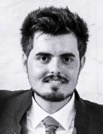Biosciences and Biotechnologies Institute of Aix-Marseille (BIAM), CEA, CNRS and Aix-Marseille University, F-13108, Saint-Paul-lez-Durance An algal photoenzyme converts fatty acids to hydrocarbons.Science 2017-357:903-907 Sorigué D, Légeret B, Cuiné S, Blangy S, Moulin S, Billon E, Richaud P, Brugière S, Couté Y, Nurizzo D, Müller P, Brettel K, Pignol D, Arnoux P, Li-Beisson Y, Peltier G, Beisson F.
Cv
Damien Sorigué is 28 years old and studied at the Faculty of Science in Luminy (Aix Marseille University) where he obtained a Master's degree in Microbiology, Plant Biology and Biotechnology (MBVB). He completed his Master 2 and thesis at the Biotechnology and Bioenergetics Laboratory of Bacteria and Microalgae (LB3M) Cea Cadarache - BIAM. Among other things, this laboratory studies lipid metabolism in microalgae. Damien is currently doing a post-doctoral fellowship at LB3M where he continues to work on the enzyme discovered during his thesis, Fatty acid photodecarboxylase (FAP). This enzyme, which converts fatty acids into hydrocarbons by using light energy (blue photons 400-530 nm) offers many biotechnological prospects, allowing the production of hydrocarbons in a biosourced way for chemistry, cosmetics or fuels. For basic research, photoenzymes are essential objects of study to understand the details of enzymatic mechanisms by ultrafast spectroscopy, or time-resolved crystallography (XFEL).
Contact
Principal investigator Alcasun
Biosciences and Biotechnologies Institute
Aix Marseille University - CNRS - CEA
UMR 7265/LB3M, Cadarache CEA Research Center
F-13108 Saint-Paul-lez-Durance, France
Tel : +33 4 42 25 46 51
Tel : +33 6 49 41 68 41
Abstract
Although many organisms capture or respond to sunlight, few enzymes are known to be driven by light. Among these are DNA photolyases and the photosynthetic reaction centers. Here, we show that the microalga Chlorella variabilis NC64A harbors a photoenzyme that acts in lipid metabolism. This enzyme belongs to an algae-specific clade of the glucose-methanol-choline oxidoreductase family and catalyzes the decarboxylation of free fatty acids to n-alkanes or -alkenes in response to blue light. Crystal structure of the protein reveals a fatty acid–binding site in a hydrophobic tunnel leading to the light-capturing flavin adenine dinucleotide (FAD) cofactor. The decarboxylation is initiated through electron abstraction from the fatty acid by the photoexcited FAD with a quantum yield >80%. This photoenzyme, which we name fatty acid photodecarboxylase, may be useful in light-driven, bio-based production of hydrocarbons.




